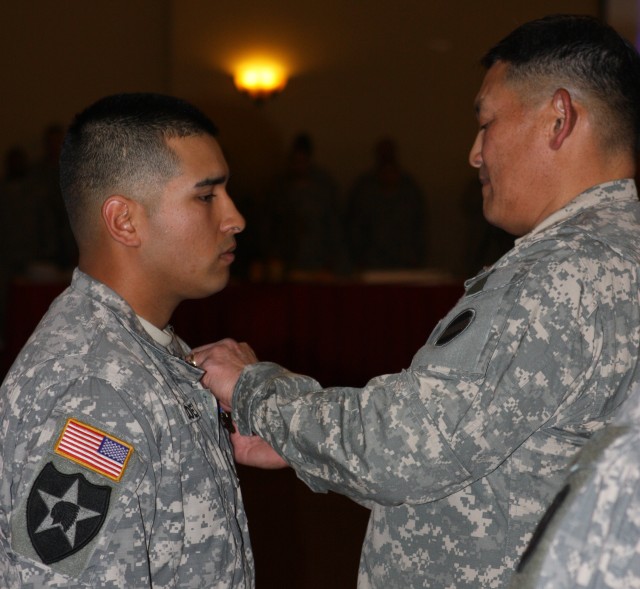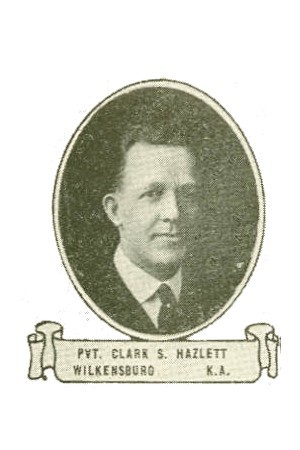Aca,!A"Extraordinary heroism in action against an enemy of the United StatesAca,!A|,Aca,!A? so begin the criteria established for the award of the Distinguished Service Cross (DSC). Over 13,400 awards of the decoration have been made to U.S. Army members since its inception on July 9, 1918. The recipients have displayed valor in the face of the enemy, often courageously facing overwhelming odds with devotion, especially to their fellow soldiers.
Nearly nine decades separate two young soldiersAca,!a,,c lives, though the circumstances surrounding their actions mirror each manAca,!a,,cs selfless service that earned him the DSC. Near Brieulles, France, on October 10, 1918, Private Clark S. Hazlett of Wilkensboro, Pennsylvania, was fighting as a member of the Machine Gun Company, 132nd Infantry Regiment, of the 33rd Division. Aca,!A"On hearing the call for aid by several men who had been hit by shellfire, Private Hazlett rushed to their aid, and although exposed to heavy artillery fire and machine-gun fire, he applied first aid to the wounded men. While in the act of placing the wounded on litters, he was killed.Aca,!A?
On May 22, 2007, a young soldier found the courage in Aca,!A"his own soulAca,!A? to save fellow soldiers. Specialist Erik Oropeza, of Los Angeles, California, a member of the 4th Battalion, 9th Infantry Regiment, of the 2nd Infantry Division was driving a Stryker Armored Personnel Carrier. His vehicle came under small arms fire and was then struck by an improvised explosive device. The vehicle was destroyed, killing two Soldiers and leaving him with a severe concussion. Climbing out of the vehicle, he was exposed to enemy fire while retrieving the nearest working weapon. He engaged five insurgents, causing the enemy to retreat and allowing him to render first aid to his surviving comrades. While again engaging the returning enemy, he attempted to radio other Stryker units but found his radio was damaged. Leaving cover, he sprinted nearly 80 yards towards reinforcements, stopping sporadically to engage the enemy. Reaching the U. S. units, he relayed his crew's position, reloaded, and re-engaged the enemy until the Quick Reaction Force arrived and forced the enemy to withdraw.
Records of the awards of the Distinguished Service Cross are filled with such examples of courage in the face of the enemy. Many reflect the selfless acts of soldiers in combat who display extraordinary heroism while rendering aid to fallen comrades -- from an Army cook who, though mortally wounded in an artillery barrage, still directed efforts to save other members of his Field Kitchen crew; to an Infantry Corporal who, knowing he was mortally wounded, refused to permit stretcher bearers to remove him, instead Aca,!A?urging them to care for othersAca,!A? less injured.
The Distinguished Service Cross represents acts of heroism that are so notable and that involve the risk of life Aca,!A"so extraordinary as to set the individual apart from his comrades.Aca,!A? It may be awarded both to military members and to civilians serving in any capacity with the U. S. Army who distinguish themselves by heroic actions in combat. The Aca,!A"CrossAca,!A? was designed by 1st Lieutenant Andre Smith and Captain Aymar Embury, and the final design was sculpted by John R. Sinnock at the Philadelphia Mint. The medal is a cross with an eagle with spread wings centered on the cross with a wreath of laurel leaves behind. The words Aca,!A"FOR VALORAca,!A? appear on a scroll at the base of the laurel wreath. The eagle represents the United States, and the laurel wreath depicts victory and achievement. The decorationAca,!a,,cs ribbon consists of a one-inch wide center of national blue edged in white and red on the outer edge. The national colors are taken from the flag, with red standing for sacrifice, white for purity, and blue for high purpose.
One of the Seven Army Values is Loyalty: Aca,!A"Bear true faith and allegiance to the U.S. constitution, the Army, and other soldiers.Aca,!A? Another is Courage: Aca,!A"Face fear, danger, or adversity.Aca,!A? We honor the Aca,!A"Extraordinary heroismAca,!A|Aca,!A? of all recipients of the Distinguished Service Cross for their extraordinary Aca,!A"LoyaltyAca,!A? and Aca,!A"Courage.Aca,!A?
ABOUT THIS STORY: Many of the sources presented in this article are among 400,000 books, 1.7 million photos and 12.5 million manuscripts available for study through the U.S. Army Military History Institute (MHI). The artifacts shown are among nearly 50,000 items of the Army Heritage Museum (AHM) collections. MHI and AHM are part of the: Army Heritage and Education Center (AHEC), 950 Soldiers Drive, Carlisle, PA, 17013-5021.








Social Sharing